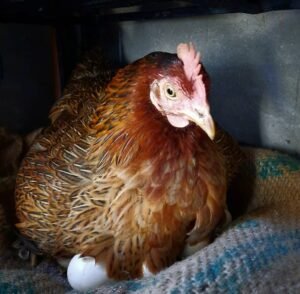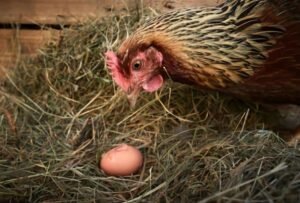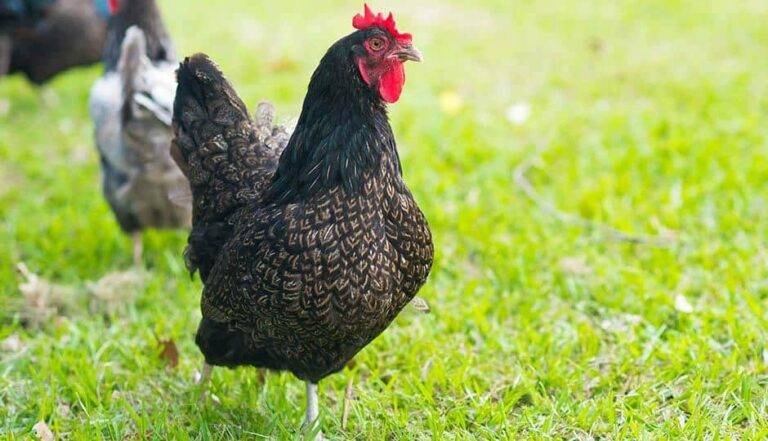Top 10 Chicken Breeds That Lay Large Eggs [With Pictures]

Everyone likes things that are large and it’s no surprise that you are looking for chickens that lay really large eggs.
If you are into the commercial egg production business, then you will agree with me that you make more money when your chickens lay large eggs.
That is because large eggs are relatively more expensive than smaller ones.
Also, customers always prefer to buy larger eggs because obviously, it’s large and it is attractive, and has more content.
In our other article “The Best Chicken Breeds for Eggs,” we made a list of the best egg-laying chickens suitable for the egg production business.
Unfortunately, not all chickens that lay plenty of eggs produce jumbo-sized eggs.
So, in this article, you will get to see the list of chickens that lay really large eggs.
Interestingly, some of the best egg-laying chickens also made it to this list.
In addition, you learn about some of the factors that can make a chicken lay large eggs and get answers to FAQs.
So, if you are ready to get the details, then let’s dive right in.
You may also like to read about How to Hatch Chicken Eggs Step by Step.

What are the different egg sizes?
Since you’re on the lookout for big size eggs, it’s important you know that chicken eggs come in sizes.
Here are the different egg sizes and weights as per U.S. Standards:
| Peewee | 1.25 oz |
| Small | 1.50 oz |
| Medium | 1.75 oz |
| Large | 2.00 oz |
| Extra-large | 2.25 oz |
| Jumbo | 2.50 oz |
What factors determine the size of a chicken egg?
So, before we list the chickens that lay large eggs, it’s important you know that certain factors determine whether or not a chicken will lay large eggs.
Below are the factors that determine the size of a hen’s egg;
1. Chicken weight is directly proportional to the size of the eggs.
Whether you believe it or not, chicken eggs are scientifically classified.
As documented by the Egg Safety Center, chicken eggs are in different sizes and classifications.
And in this classification, the size of a chicken does not have much to do with the size of its egg. Rather it’s the chicken weight.
Therefore, the factor that determines whether a chicken lays pee wee or small, medium, large or bigger eggs is the weight of the chicken.
In other words, weightier chickens lay jumbo size eggs.
Actually, it’s the most important factor that determines the size of a chicken egg.
2. The feed a chicken eats determines the weight of its eggs.
There is a popular computer concept that goes thus, “garbage in, garbage out”.
The same thing applies to hens when it comes to laying eggs.
Since the weight of a chicken determines the egg size, the kind of feed the birds are fed is quite essential.
To get large healthy birds, you have to feed them well.
Providing the birds with a diet that supplies all nutrients should manipulate and produce the preferred early egg size.
A feed with high protein content will do the job.
By altering the protein level in chicken feed, the egg size can be altered at different stages of production.
Here’s what we propose, feed the birds feeds containing an 18-20% protein layer ratio in the first 3 egg production months.
After the flock has reached maximum egg production, high protein feeds will no longer promote large egg production.
At 8-10 months, cut down protein to 15-17%.
Also, by fermenting the chicken feed before feeding them, it will be easy for you to fatten the flock.
3. The size of a chicken egg is determined by the amount of light the chicken gets.
When we mean light, it involves both natural and artificial light.
The amount of light the flock gets will influence the egg size. It can also accelerate or delay the age at which hens start to lay eggs.
Therefore, the younger a hen is when she starts to lay eggs, the smaller her eggs will be during her first year of life.
In other words, to delay production, you can provide just 10 hours of light or less each day until they are 19 weeks of age.
You can increase the duration of light when they are mature for egg production.
4. The skeletal size of chickens determines if they will lay large eggs or not.
Hens with bigger and longer bones tend to become bigger hens. And if they become bigger hens, they will lay bigger eggs.
We found out that chicken breeds with genetically larger skeletons lay large eggs.
To influence the skeletal size of the flock, it’s best to feed them protein level feeds in the ration fed before 10 weeks of age.
If you want pullets with bigger skeletons, let them feed on a starter diet until 8 or 10 weeks of age.
5. Predators are a huge disadvantage to the laying of large eggs.
With the presence of predators, the chickens will focus on safety measures rather than foraging and the production of eggs.
Just like stress affects conception in humans, predator stress can affect the conception and the size of an egg.
This is a psychological stressor that limits egg production.
It also affects the size of the eggs because most times they are laid prematurely.
And sometimes the egg formation process is altered.
Well, this wouldn’t be much of a problem if you employ the process to curb it.
Creating a pen for your chickens will keep their minds away from predators.
All your hens can do now is concentrate and lay plenty of eggs every week.
These factors we listed above greatly influence how soon the chickens start to lay large eggs.
Other factors such as crowding, heat stress, or inadequate water supply, will reduce the egg size of chickens.
With that being said, you will be at a better advantage of more large eggs if you choose breeds genetically designed for larger egg sizes.
So, let’s find out about the large egg-laying birds next!
Top 10 chicken breeds that lay large eggs
Without further ado, I present to you the top breeds of chickens that lay large eggs…
1. Minorca chickens:

By nature, the Minorca chickens are birds that are large, friendly, and easy to handle.
Their beautiful glossy black plumes and rich red face with white earlobes make them a huge attraction.
In addition to their beautiful features and characteristics, the Minorca chickens usually lay about 200 or more eggs every year.
Of course, their eggs are pretty large and white in color.
People who read about Minorca chickens also read about the 15 Black Chicken Breeds You Should Know About (With Pictures).
2. Leghorn Chickens:

Next on our list of chickens that lay large eggs is the Leghorns.
The Leghorns also produce white jumbo eggs. Most of the eggs you see in the grocery stores are white Leghorns.
They usually lay 250-289 eggs in a year.
3. Lohmann Brown chickens:

The Lohmann Brown chickens are one of the best hybrid chickens you can keep for eggs.
They are a hybrid of the New Hampshire chickens. Usually, they are kept for their brown eggs.
These birds begin laying large-sized eggs after 4-5 months from hatching.
You should expect about 300 large brown eggs in a year from your Lohmann.
You may also like to read this article about the Top 15 Brown Chicken Breeds for Backyard Poultry (With Pictures).
4. Production Reds – Rhode Island Red chicken:

Production Reds are a variant of the Rhode Island Red.
They are the industrial production strain.
Originally, these birds were bred because they are productive layers.
But their heavy nature makes them a good option for meat.
The Production Red lays large brown eggs consistently.
In a year, you can expect 300 or more eggs per hen.
5. Welsummer chickens:

The Welsummers are dual-purpose birds. When it comes to their eggs, they lay really exceptional eggs with an unusual color.
Their eggs are large dark reddish-brown. It almost has a terracotta color.
The egg from their adult hens consistently hit the large and extra-large USDA weights.
This makes it the local farmers’ favorite.
Also, these birds are known to mature quickly for meat.
Although they are consistent layers, these chickens’ production of large eggs will slow down in winter.
6. Barnevelder chickens:

This is another chicken that lays jumbo size eggs.
The Barnevelder chickens lay very large to extra-large dark brown-colored eggs.
Because they are hardy in winter, you can trust them to lay eggs consistently.
And they maintain the same egg size all things being equal.
7. Delaware chickens:

The Delaware chickens are a hybrid of the Barred Plymouth Rocks and New Hampshire Reds.
We know them to be good egg layers. They start laying at 20 weeks.
Their eggs are brown and beautiful brown. And coming from a white bird, it’s simply phenomenal.
If you own a Delaware, you can trust them to lay large to jumbo brown eggs even in cold months.
8. Buff Orpington chickens:

This Queen Elizabeth fluffy favorite chicken makes it to the list of chickens that lay large eggs.
You can expect to lay about 280 in a year. Their eggs are large beautiful pearlescent brown-colored.
Although the Orpington chickens are cold-hardy, they do not do well in warmer temperatures.
Orpington chickens are one of the largest chicken breeds in the world. Read this article to see all 17 Largest Chicken Breeds in the World (With Pictures).
9. Speckled Sussex chicken breed:

If you want a chicken that keeps laying large eggs regardless of the season, the Speckled Sussex chicken is a good option.
They lay large to extra large light brown eggs.
Besides their large eggs, these chickens are known mainly as meat birds in England.
10. Golden Comets hybrid chicken:

This is another hybrid chicken that lays many large eggs.
It’s a Rhode Island Red and White Leghorn cross with amazing qualities
Their fast maturing and early egg-laying nature make them an attraction to farmers.
Golden Comets lay huge deep red-brown eggs. Usually, they lay about 330 eggs in a year.
Also, they add consistent egg layers.
Conclusion: Chickens that lay large eggs
By virtue of this article, you must have known that you can determine the size of eggs your hens lay by tweaking some factors.
As we earlier stated, large eggs are better gotten if you have birds who by nature lay large birds.
Do well to leave a comment in the comment section.
Also, explore the site for other articles that will help you on your farm.
Frequently asked questions about chickens that lay large eggs.
Do chickens start laying large eggs on the first production?
Well, that’s a probability.
Although most hens start egg production by laying pee wee or small eggs, some can lay large eggs for a start.
With time, the small eggs gradually increase to a mature egg grade size of medium, large, jumbo, or extra-large.When do I expect my chickens to lay large eggs?
In modern breeds, most hens start laying large eggs by 40 weeks of age.
But there are exceptions to that.
The Delaware chickens start laying large eggs at 20 weeks whereas the Lohmann Brown chickens start laying at 4-5 weeks from hatching.
What you should know is that certain conditions make any hen lay larger and healthier eggs.
So, it’s important that all things are equal for the eggs to lay large eggs.Can I affect the size of eggs my hen is laying?
In one word, the answer is – Yes. There are some stunts you can pull to change the size of eggs your hens lay. Fermenting their chicken feed is a good start.
References
- 12 Best Chicken breeds for Eggs – chicken breeds for eggs
- When Do Chickens Start Laying Eggs Regularly?
- How Many Eggs Does A Chicken Lay In A Week?
- Fermenting chicken feed – The definitive guide
- 10 Sure Ways To Stop Chickens from Eating Their Eggs [+Bonus]
- 6 Best Chicken Egg Incubators for Chicken Eggs and Other Birds











